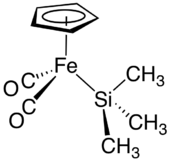Silylation
Silylation is the introduction of a (usually) substituted silyl group (R3Si) to a molecule. The process is the basis of organosilicon chemistry.
Of organic compounds
Alcohols, carboxylic acids, amines, thiols, and phosphates can be silylated. The process involves the replacement of a proton with a trialkylsilyl group, typically trimethylsilyl (-SiMe3). Generally the substrate is deprotonated with a suitable strong base followed by treatment with a silyl chloride (e.g. trimethylsilyl chloride). Often strong bases such butyl lithium or a Grignard reagent are used, as illustrated by the synthesis of a trimethylsilyl ethers as protecting groups from an alcohol:
- ROH + BuLi → ROLi + BuH
- ROLi + Me3SiCl → ROSiMe3 + LiCl
Bis(trimethylsilyl)acetamide ("BSA", Me3SiNC(OSiMe3)Me is an efficient silylation agent used for the derivatisation of compounds. The reaction of BSA with alcohols gives the corresponding trimethylsilyl ether, together with N-(trimethylsilyl)acetamide as a byproduct:
- ROH + Me3SiNC(OSiMe3)Me → Me3SiN(H)C(O)Me + ROSiMe3
acetamide.png) Bis(trimethylsilyl)acetamide, a popular reagent for silylation.
Bis(trimethylsilyl)acetamide, a popular reagent for silylation.
The introduction of a silyl group(s) gives derivatives of enhanced volatility, making the derivatives suitable for analysis by gas chromatography and electron-impact mass spectrometry (EI-MS). For EI-MS, the silyl derivatives give more favorable diagnostic fragmentation patterns of use in structure investigations, or characteristic ions of use in trace analyses employing selected ion monitoring and related techniques.[1][2]
Desilylation
Desilylation is the reverse of silylation: the silyl group is exchanged for a proton. Various fluoride salts (e.g. sodium, potassium, tetra-n-butylammonium fluorides) are popular for this purpose.[3][4]
- ROSiMe3 + F− + H2O → ROH + FSiMe3 + OH−
Of metals

Coordination complexes with silyl ligands are well known. An early example is CpFe(CO)2Si(CH3)3, prepared by a salt metathesis reaction from trimethylsilyl chloride and CpFe(CO)2Na. Typical routes include oxidative addition of Si-H bonds to low-valent metals. Metal silyl complexes are intermediates in hydrosilation, a process used to make organosilicon compounds on both laboratory and commercial scales.[5][6]
See also
References
- http://www.sigmaaldrich.com/analytical-chromatography/analytical-reagents/derivatization-reagents/silylation.html
- Blau, Karl; J. M. Halket (1993). Handbook of Derivatives for Chromatography (2nd ed.). John Wiley & Sons. ISBN 0-471-92699-X.
- Mercedes Amat, Sabine Hadida, Swargam Sathyanarayana, and Joan Bosch "Regioselective Synthesis of 3-Substituted Indoles: 3-Ethylindole" Organic Syntheses 1997, volume 74, page 248. doi:10.15227/orgsyn.074.0248
- Nina Gommermann and Paul Knochel "N,N-Dibenzyl-n-[1-cyclohexyl-3-(trimethylsilyl)-2-propynyl]-amine from Cyclohexanecarbaldehyde, Trimethylsilylacetylene and Dibenzylamine" Organic Syntheses 2007, vol. 84, page 1. doi:10.15227/orgsyn.084.0001
- Moris S. Eisen "Transition-metal silyl complexes" in The Chemistry of Organic Silicon Compounds. Volume 2 Edited by Zvi Rappoport and Yitzhak Apeloig, 1998, John Wiley & Sons.
- Corey, J. Y.; Braddock-Wilking, J., "Reactions of Hydrosilanes with Transition-Metal Complexes: Formation of Stable Transition-Metal Silyl Compounds", Chem. Rev. 1999, vol. 99, pp. 175-292.doi:10.1021/CR9701086